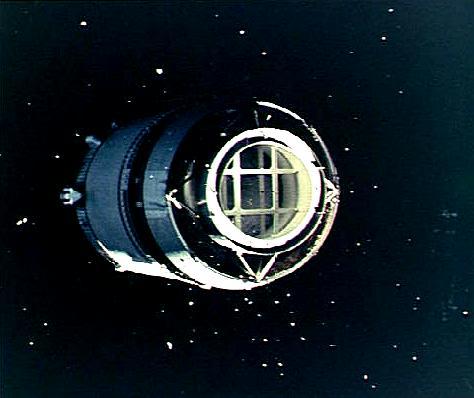
Home - Search - Browse - Alphabetic Index: 0- 1- 2- 3- 4- 5- 6- 7- 8- 9
A- B- C- D- E- F- G- H- I- J- K- L- M- N- O- P- Q- R- S- T- U- V- W- X- Y- Z
Apollo LTA

Apollo LTA
View of the Saturn V third stage from which the Apollo 8 has separated
Credit: NASA
AKA: Lunar module Test Article. Status: Operational 1967.
Several were used in test flights of Saturn launch vehicles, most famously in Apollo 8.
Family: Technology, Technology satellite. Country: USA. Launch Vehicles: Saturn V. Agency: NASA Huntsville. Bibliography: 16.
1968 August 9 - . Launch Vehicle: Saturn V.
- Senior Apollo porject management backs Apollo 8 lunar mission concept - . Nation: USA. Related Persons: Low, George, von Braun. Program: Apollo. Flight: Apollo 7, Apollo 8, Apollo 9. Spacecraft: Apollo CSM, Apollo LTA. August 9 was probably one of the busiest days in George Low's life; the activities of that and the following days enabled the United States to meet the "in this decade" goal.. Additional Details: here....
1968 August 10 - . Launch Vehicle: Saturn V.
- North American not enthusiastic about plan to send Apollo 8 to moon. - . Nation: USA. Related Persons: Low, George. Program: Apollo. Flight: Apollo 7, Apollo 8. Spacecraft: Apollo CSM, Apollo LTA. More detailed reviews within NASA showed there were still no obvious insurmountable problems that might block the plan. However North American was not too receptive to the idea.. Additional Details: here....
1968 August 12 - . Launch Vehicle: Saturn V.
- Apollo 8 lunar mission scheduled for December 20. - .
Nation: USA.
Related Persons: Low, George.
Program: Apollo.
Flight: Apollo 8.
Spacecraft: Apollo CSM,
Apollo LTA.
On August 12 Kraft informed Low that December 20 was the day if they wanted to launch in daylight. With everyone agreeing to a daylight launch, the launch was planned for December 1 with a "built-in hold" until the 20th, which would have the effect of giving assurance of meeting the schedule. LTA (LM test article)-B was considered as a substitute; it had been through a dynamic test vehicle program, and all except Kotanchik agreed this would be a good substitute. Grumman suggested LTA-4 but Low decided on LTA-B.
1968 August 27 - . Launch Vehicle: Saturn V.
- Decision to use Apollo LTA-B as payload ballast on the AS-503 flight - .
Nation: USA.
Related Persons: Low, George.
Program: Apollo.
Flight: Apollo 8.
Spacecraft: Apollo LTA,
LM Weight.
George M. Low, ASPO Manager, set forth the rationale for using LTA-B (as opposed to some other LM test article or even a full-blown LM) as payload ballast on the AS-503 mission. That decision had been a joint one by Headquarters, MSFC, and MSC. Perhaps the chief reason for the decision was Marshall's position that the Saturn V's control system was extremely sensitive to payload weight. Numerous tests had been made for payloads of around 38,555 kilograms but none for those in the 29,435- to 31,750-kilogram range. MSFC had therefore asked that the minimum payload for AS-503 be set at 38,555 kilograms. Additional Details: here....
1968 November 10 - . Launch Vehicle: Saturn V.
- Success of Apollo 7 clears way for Apollo 8 lunar orbit mission in December. - .
Nation: USA.
Related Persons: Low, George.
Program: Apollo.
Flight: Apollo 7,
Apollo 8.
Spacecraft: Apollo CSM,
Apollo LTA.
Apollo 7 - flown October 11-22 - far exceeded Low's expectations in results and left no doubts that they should go for lunar orbit on Apollo 8. At the November 10 Apollo Executive meeting Phillips presented a summary of the activities; James gave the launch vehicle status; Low reported on the spacecraft status and said he was impressed with the way KSC had handled its tight checkout schedule; Slayton reported on the flight plan; and Petrone on checkout readiness. Petrone said KSC could launch as early as December 10 or 12. Phillips said he would recommend to the Management Council the next day for Apollo 8 to go lunar orbit. Additional Details: here....
1968 November 11 - . Launch Vehicle: Saturn V.
- Paine gives Apollo 8 go-ahead for lunar orbit mission. - . Nation: USA. Related Persons: Low, George, Paine. Program: Apollo. Flight: Apollo 8. Spacecraft: Apollo CSM, Apollo LTA. Low's initiative had paid off; the final decision to go to the moon in 1968 was made with the blessings of all of NASA's decision-makers, the Apollo Executive Committee, STAC, and PSAC..
Back to top of page
Home - Search - Browse - Alphabetic Index: 0- 1- 2- 3- 4- 5- 6- 7- 8- 9
A- B- C- D- E- F- G- H- I- J- K- L- M- N- O- P- Q- R- S- T- U- V- W- X- Y- Z
© 1997-2019 Mark Wade - Contact
© / Conditions for Use